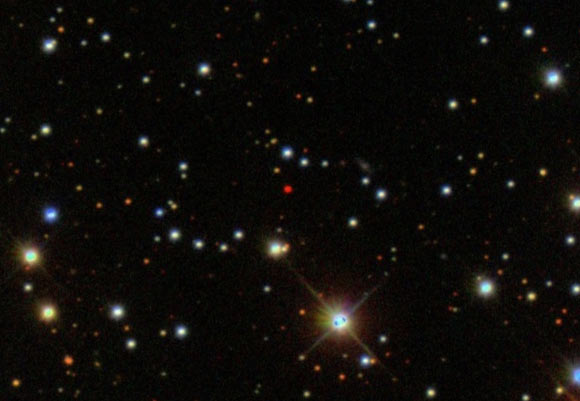Astronomers using NASA’s flagship space telescopes, Kepler and Spitzer, have discovered a raging, giant storm on a cool Jupiter-size star called W1906+40.

The L-type dwarf W1906+40 is a red object in the center of this image. Image credit: SDSS / Centre de Données astronomiques de Strasbourg / SIMBAD.
W1906+40 (full name WISEP J190648.47+401106.8) is a so-called L-type dwarf discovered by NASA’s Wide-field Infrared Survey Explorer in 2011.
It is located in the constellation Lyra about 53 light-years from Earth.
Some L-dwarfs are considered stars because they fuse atoms and generate light, while others, brown dwarfs, are known as failed stars for their lack of atomic fusion.
W1906+40 is thought to be a star based on estimates of its age. Its temperature is approximately 3,500 degrees Fahrenheit (1,927 degrees Celsius).
“The star is the size of Jupiter, and its storm is the size of Jupiter’s Great Red Spot. We know this newfound storm has lasted at least two years, and probably longer,” said team member Dr John Gizis, of the University of Delaware.
NASA’s Kepler and Spitzer space telescopes cannot see W1906+40’s storm system itself, but learned of its presence after observing how the dwarf’s light changes over time.
The storm travels around with W1906+40, making a full lap about every 9 hours.
When it passes into a telescope’s field of view, it causes light of particular infrared and visible wavelengths to dip in brightness.
The location of the storm is estimated to be near W1906+40’s north pole based on computer models of the data.
“We don’t know if this kind of star storm is unique or common, and we don’t why it persists for so long,” said Dr Gizis, who is the first author of a paper published in the Astrophysical Journal (arXiv.org preprint).
He and his colleagues plan to look for other unusual stars and brown dwarfs using NASA’s telescopes in the future.
_____
John E. Gizis et al. 2015. Kepler Monitoring of an L Dwarf II. Clouds with Multiyear Lifetimes. ApJ 813, 104 ; doi: 10.1088/0004-637X/813/2/104







